Germany ships a frigate to secure safe shipping in the Red Sea
Some shipping companies have decided to reroute their vessels away from the Red Sea due to the unrest, resulting in a longer and more expensive route around the southern tip of Africa

The "Hesse" frigate will be able to respond to potential Yemeni rebel attacks including from missiles, drones and remotely controlled "kamikaze boats", Germany's navy chief said © FOCKE STRANGMANN / AFP
Germany’s navy chief Jan Christian Kaack said Thursday, their deployment was “the most serious engagement of a unit of the German navy in many decades,” he told reporters in Berlin.
Since November, the Huthi rebels in Yemen, who are supported by Iran, have attacked multiple ships that are traversing the Red Sea. They have claimed that their campaign is in support of the Palestinian people in the conflict between Israel and Hamas.
Typically, the Red Sea handles 12% of all maritime trade worldwide.
Related Articles
Some shipping companies have decided to reroute their vessels away from the Red Sea due to the unrest, resulting in a longer and more expensive route around the southern tip of Africa.
The “Hesse” frigate set off from the northern German port of Wilhelmshaven with a crew of around 240 people, Kaack said.
It will be able to respond to potential attacks including from missiles, drones and remotely controlled “kamikaze boats”, he said.
It is expected to be tasked with escorting commercial ships and intercepting attacks.
The frigate’s mission still needs to be confirmed by the German parliament and the European Union, however.
The EU is currently considering a naval mission to improve security for merchant ships in the Red Sea.
A decision could be announced before the next meeting of EU foreign ministers on February 19.
Countries including Italy, France and Belgium have signalled an interest in joining the mission.
US and British forces meanwhile have in recent weeks carried out joint strikes aimed at reducing the Huthis’ ability to target vessels transiting the key Red Sea trade route, but the rebels have vowed to continue their attacks.
Most trade between Asia and Europe usually passes through the Red Sea and the Suez Canal that leads to the Mediterranean Sea.
According to the International Monetary Fund’s PortWatch platform, total transit volume through the Suez Canal was down 37 percent this year by January 16 compared with the same period a year earlier.
(with inputs from the AFP)
Join our Whatsapp channel to get the latest global news updates
also read

US bolsters defences around Jordan base as it readies strikes in response to drone attack
The U.S. has also tried more limited military responses in a series of strikes against weapons storage sites and training areas. So far, the U.S. response has not deterred the groups, which have attacked U.S. facilities at least 166 times since October.

16,000 sheep, cattle stranded at sea amid Red Sea crisis: How live exports put animals at risk
Roughly 14,000 sheep and 2,000 cattle on board a ship bound for Israel have been stranded near the coast of Australia after the vessel abandoned its journey owing to Houthi attacks in the Red Sea. This incident shines a spotlight on the inhumane treatment meted out to animals during live export

Red Sea Crisis: Maersk says shipping disruption poses uncertainty to 2024 earnings
Since November, the rebels have repeatedly targeted ships in the Red Sea over Israel’s offensive in Gaza. But they have frequently targeted vessels with tenuous or no clear links to Israel, imperilling shipping in a key route for trade among Asia, the Mideast and Europe.


